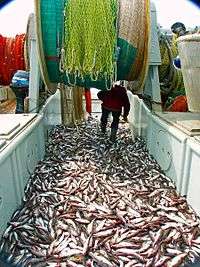Rivalry (economics)
In economics, a good is said to be rivalrous or a rival if its consumption by one consumer prevents simultaneous consumption by other consumers,[1] or if consumption by one party reduces the ability of another party to consume it. A good is considered non-rivalrous or non-rival if, for any level of production, the cost of providing it to a marginal (additional) individual is zero.[2] A good can be placed along a continuum ranging from rivalrous to non-rivalrous. The same characteristic is sometimes referred to as jointness of supply or subtractable or non-subtractable.[3]

Most tangible goods, both durable and nondurable, are rival goods. A hammer is a durable rival good. One person's use of the hammer presents a significant barrier to others who desire to use that hammer at the same time. However, the first user does not "use up" the hammer, meaning that some rival goods can still be shared through time. An apple is a nondurable rival good: once an apple is eaten, it is "used up" and can no longer be eaten by others. Non-tangible goods can also be rivalrous. Examples include the ownership of radio spectra and domain names. In more general terms, almost all private goods are rivalrous.
In contrast, non-rival goods may be consumed by one consumer without preventing simultaneous consumption by others. Most examples of non-rival goods are intangible. Broadcast television is an example of a non-rival good; when a consumer turns on a TV set, this does not prevent the TV in another consumer's house from working. The television itself is a rival good, but television broadcasts are non-rival goods. Other examples of non-rival goods include a beautiful scenic view, national defense, clean air, street lights, and public safety. More generally, most intellectual property is non-rival. In fact, certain types of intellectual property become more valuable as more people consume them (anti-rival). For example, the more people use a particular language, the more valuable that language becomes.
Non-rivalry does not imply that the total production costs are low, but that the marginal production costs are zero. In reality, few goods are completely non-rival as rivalry can emerge at certain levels. For instance, use of public roads, the Internet, or police/law courts is non-rival up to a certain capacity, after which congestion means that each additional user decreases speed for others. For that, recent economic theory views rivalry as a continuum, not as a binary category,[4] where many goods are somewhere between the two extremes of completely rival and completely non-rival. A perfectly non-rival good can be consumed simultaneously by an unlimited number of consumers.
There are four types of goods based on the characteristics of rival in consumption and excludability: Public Goods, Private Goods, Common Resources, and Natural Monopolies.[5]
Goods that are both non-rival and non-excludable are called public goods. Examples include clean air, national defense, and free-to-air broadcast TV. It is generally accepted by mainstream economists that the market mechanism will under-provide public goods, so these goods have to be produced by other means, including government provision.
On the other hand, private goods are rival and excludable. This includes things like a personal book. It is excludable because the owner can prevent anyone else from reading their book, and it is rival because one person reading it prevents another from reading it at the same time.
For goods that are both non-rival and excludable are called natural monopolies. For example, fire stations can exclude people by decide to letting their house burn down. However, the fire protection is not rival in consumption, once a fire department is built and paid taxes to, it doesn't cost much more to protect one more house.
Common resources are rival in consumption and non-excludable. This includes fish in the sea. When someone catches many fish, there are now fewer fish for the next person who comes by. But, since the ocean is so big, there's no way to exclude other people from fishing.
References
- David L. Weimer; Aidan R. Vining (2005). Policy Analysis: Concepts and Practice. Pearson: Prentice Hall. p. 72. ISBN 0-13-183001-5. Fourth Edition.
- Cornes, R., T. Sandler. 1986. The theory of externalities, public goods, and club goods. Cambridge University Press.
- Hess, C., E. Ostrom. 2006. Introduction. C. Hess, E. Ostrom, eds. Understanding Knowledge as a Commons: From Theory to Practice. The MIT Press, Cambridge, Massachusetts
- Leach, J. 2004. A course in public economics. Cambridge University Press: 155–56
- Mankiw, N. Gregory. (2012). Principles of microeconomics (6th ed.). Mason, OH: South-Western Cengage Learning. ISBN 978-0-538-45304-2. OCLC 742415439.
See also
- The generalized network effect of microeconomics.
- Metcalfe's law
- Anti-rival good